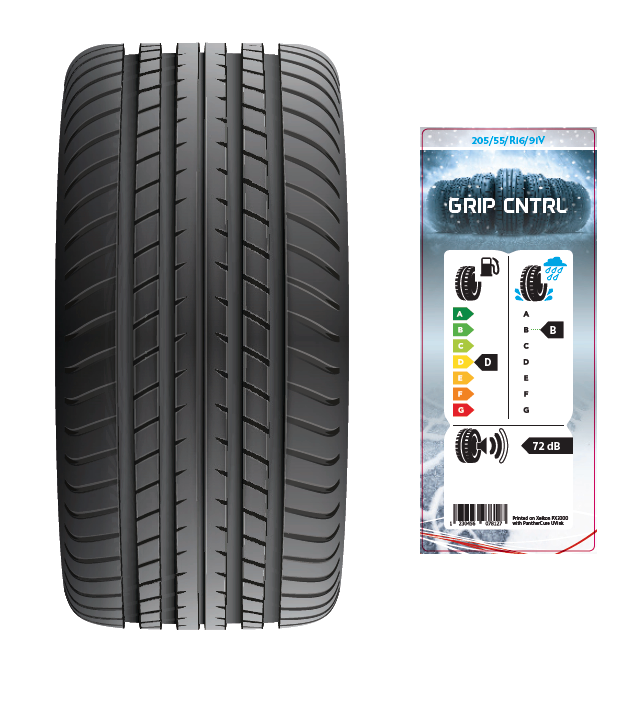Thanks to low surface energy, road tread patterns and tiny rubber hairs, labels have a tough time just sticking to a tire. Once adhered, they are then subject to big variations in temperature, humidity and abrasion during transport and storage. Even if these labels arrive intact into the showroom, carbon black can migrate out of tires over time, making new labels appear dirty. In the past, these quality issues were of little concern to tire brands. That changed in 2012, when the European Union passed legislation requiring tire labels to indicate energy efficiency and safety features. Other countries consider similar regulations.With more consumer-oriented information on tire labels, expectations for quality and brand appeal have increased, driving a number of significant trends - and innovations in tire labeling. Trend- Brand appeal: Label quality is critical at every stage of a tire’s life cycle. It has an impact on productivity during manufacturing, efficiency during distribution and consumer behavior at the point of sale. If a label is stained with carbon, consumers may perceive a tire as old stock and look elsewhere. In the past many tire layers were backed with a layer of aluminum to prevent carbon black from migrating out of the tire into the label.

Background
Thanks to low surface energy, road tread patterns and tiny rubber hairs, labels have a tough time just sticking to a tire. Once adhered, they are then subject to big variations in temperature, humidity and abrasion during transport and storage. Even if these labels arrive intact into the showroom, carbon black can migrate out of tires over time, making new labels appear dirty. In the past, these quality issues were of little concern to tire brands. That changed in 2012, when the European Union passed legislation requiring tire labels to indicate energy efficiency and safety features. Other countries consider similar regulations.With more consumer-oriented information on tire labels, expectations for quality and brand appeal have increased, driving a number of significant trends - and innovations in tire labeling. Trend- Brand appeal: Label quality is critical at every stage of a tire’s life cycle. It has an impact on productivity during manufacturing, efficiency during distribution and consumer behavior at the point of sale. If a label is stained with carbon, consumers may perceive a tire as old stock and look elsewhere. In the past many tire layers were backed with a layer of aluminum to prevent carbon black from migrating out of the tire into the label.
What is the value of digital printing?
In Europe, the format in which information such as energy performance, noise, etc. of a tire label has to be presented is
regulated. This leaves very little options to increase the shelf appeal of a tire using its label.
Digital printing can allow to adapt the visuals around the regulated area.
In this example, the desert and star sky background are also part of the variable information.
Digital printing allows to print the required variable information to sell / ship tires in markets such as Dubai, which require an unique barcode or QR code on the label, to ensure the authenticity of the tires. This prevents in-line printing to complete the labels with the required variable information. With UV Inkjet printing, each label can be uniquely printed
Durability
The durability performance of the label is tested on labels printed on a Xeikon PX3300 press, with PantherCure UV inks and substrate Avery Dennison PP NG TOP WH - TS8000 - BG45WH (AF548) AND Avery PP LIGHT TOP SILVER - TS8000- BG45WH (AQ409)
| Durability requirements | Durability performance of label* | |
| Scratch resistance | ++ | +++ |
| Heat resistance | + | ++ |
| Chemical resistance | + | +++ |
| UV exposure | ++ | ++ |
| BS 5609 Section2& 3 certification | No | Yes |
| UL, CSA recognition certification | No | No |
* + = medium durability, ++ = high durability, +++ = very high durability
Production details
Here you can see a sample of a car tire label printed on a Xeikon PX3300 digital press.
• Print dimensions: 95 x 225 mm
• Substrate: Avery Dennison PE100 TOP WH- S477 - BG40WH (BB697)
• Toner: PantherCure UV ink
The Xeikon PX3300 has been the press of choice due to the durable characteristics of the PantherCure UV inks and the unlimited repeat length for any size of labels.

